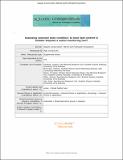Files in this item
Assessing cetacean body condition : is total lipid content in blubber biopsies a useful monitoring tool?
Item metadata
| dc.contributor.author | Kershaw, Joanna L. | |
| dc.contributor.author | Brownlow, Andrew | |
| dc.contributor.author | Ramp, Christian A. | |
| dc.contributor.author | Miller, Patrick J.O. | |
| dc.contributor.author | Hall, Ailsa J. | |
| dc.date.accessioned | 2020-09-05T23:35:07Z | |
| dc.date.available | 2020-09-05T23:35:07Z | |
| dc.date.issued | 2019-09-06 | |
| dc.identifier | 261123827 | |
| dc.identifier | 6f1de892-bf0c-4fb8-a877-247a8f5eee45 | |
| dc.identifier | 85071868896 | |
| dc.identifier | 000484997200019 | |
| dc.identifier.citation | Kershaw , J L , Brownlow , A , Ramp , C A , Miller , P J O & Hall , A J 2019 , ' Assessing cetacean body condition : is total lipid content in blubber biopsies a useful monitoring tool? ' , Aquatic Conservation: Marine and Freshwater Ecosystems , vol. 29 , no. S1 , pp. 271-282 . https://doi.org/10.1002/aqc.3105 | en |
| dc.identifier.issn | 1052-7613 | |
| dc.identifier.other | RIS: urn:4AFF6BC0FE926E93441E7C4587BC5A70 | |
| dc.identifier.other | ORCID: /0000-0002-7562-1771/work/61622033 | |
| dc.identifier.uri | https://hdl.handle.net/10023/20564 | |
| dc.description | We would like to thank the funders: the Department for Environment Food and Rural Affairs and Marine Scotland, for a number of long‐term monitoring contracts awarded to SMASS, the Sea Mammal Research Unit National Capability Funding from the Natural Environment Research Council (grant no. SMRU 10001), and the Strategic Environmental Research and Development Program (award RC‐2337). | en |
| dc.description.abstract | Measuring the energy stores, or body condition, of cetaceans is vital for monitoring population health. Cetaceans are exposed to a range of anthropogenic stressors, including, for example, noise, contaminants, habitat degradation, reduced prey availability, ship strike, and entanglement. Tools to assess body condition in these inaccessible and vulnerable animals are required to better understand the energetic consequences of anthropogenic stressors that can impact population health and, ultimately, conservation status.Remotely obtained, dart biopsy samples are becoming an increasingly standard method of tissue collection from live, large cetaceans. Here, the potential applicability of using total lipid content in such biopsy samples to estimate overall body condition was assessed using full‐depth dorsal blubber samples from stranded ziphiids (n = 8) and balaenopterids (n = 9). First, variation in total lipid content through the blubber depth was investigated to assess the representativeness of shallow‐depth dart biopsies taken from live animals. Second, how lipid content varies by species, cause of death, sex, age class, and morphometric indices of body condition was assessed to evaluate what information about individual energy stores can be gained from such analyses. Total lipid content in dorsal, shallow‐depth blubber biopsy samples from both cetacean families provides little information on overall body condition. Stratification of lipid content through the blubber layer in the balaenopterids means that superficial biopsy samples are not representative of the lipid stores available for mobilization through the rest of the tissue. A lack of variation in blubber lipid content, both within and between the ziphiid individuals, resulted in no ability to correlate these measures with morphometrics or other health, sex, or age class covariates.Other potential markers in the blubber from remote biopsy sampling should be explored in order to further develop robust tools for estimating the body condition of free‐ranging cetaceans. | |
| dc.format.extent | 12 | |
| dc.format.extent | 960357 | |
| dc.language.iso | eng | |
| dc.relation.ispartof | Aquatic Conservation: Marine and Freshwater Ecosystems | en |
| dc.subject | Adipose tissue | en |
| dc.subject | Balaenopterids | en |
| dc.subject | Blubber | en |
| dc.subject | Body condition | en |
| dc.subject | Diving physiology | en |
| dc.subject | Lipids | en |
| dc.subject | Ziphiids | en |
| dc.subject | GC Oceanography | en |
| dc.subject | QH301 Biology | en |
| dc.subject | NDAS | en |
| dc.subject.lcc | GC | en |
| dc.subject.lcc | QH301 | en |
| dc.title | Assessing cetacean body condition : is total lipid content in blubber biopsies a useful monitoring tool? | en |
| dc.type | Journal article | en |
| dc.contributor.institution | University of St Andrews. School of Biology | en |
| dc.contributor.institution | University of St Andrews. Sea Mammal Research Unit | en |
| dc.contributor.institution | University of St Andrews. Scottish Oceans Institute | en |
| dc.contributor.institution | University of St Andrews. Institute of Behavioural and Neural Sciences | en |
| dc.contributor.institution | University of St Andrews. Centre for Social Learning & Cognitive Evolution | en |
| dc.contributor.institution | University of St Andrews. Bioacoustics group | en |
| dc.contributor.institution | University of St Andrews. Marine Alliance for Science & Technology Scotland | en |
| dc.identifier.doi | 10.1002/aqc.3105 | |
| dc.description.status | Peer reviewed | en |
| dc.date.embargoedUntil | 2020-09-06 |
This item appears in the following Collection(s)
Items in the St Andrews Research Repository are protected by copyright, with all rights reserved, unless otherwise indicated.

